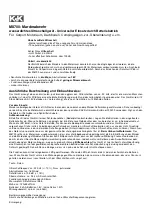
5
2020.05 / c
Electric Power Generation
Installation and maintenance
LSAH 44.3
Low Voltage Alternator - 4 pole
5577 en -
2 - TECHNICAL CHARACTERISTICS
2.1 - Electrical characteristics
This alternator is a machine without
sliprings or revolving armature brushes,
wound as “2/3 pitch”, 6-wire, with class H
insulation and a field excitation system
available in AREP version (see diagram
and AVR manual). The alternator complies
with EN 61000-6-3, EN 61000-6-2, EN
55011.
Electrical options:
- Stator temperature detection sensors
- Space heater
- R791 interference suppression
2.2 - Mechanical characteristics
- Steel frame
- Cast iron end shields
- Ball bearings greasable
- Mounting arrangements: foot and flange
mounted, single bearing with SAE coupling
disc, two-bearing with SAE flange and
standard cylindrical shaft extension
- Enclosed machine cooled by heat transfer
fluid
- Degree of protection: IP 44
T1
T2
T3
T4
T5
T6
5+
6-
D350
AREP SYSTEM
STATOR: 6-wire (marking T1 to T6)
EXCITER
Field
Armature
Varistor
Aux. windings
MAIN FIELD
Voltage reference
2.3 - Cooling circuit characteristics
- Cooling method: IC7A1W7
- Type of fluid: water + additive
- Operating temperature: 70°C (±5°C)
- Permitted additives: Glycol-type antifreeze
- Maximum level of additives: 50%
- Operating pressure: 3 bar (8 bar maximum)
Glycol (or Ethylene glycol) type
antifreeze is a hazardous product which
is harmful to health.
SGH07
SGH08
SIMDUT D2A
NFPA 704
1
2
0
Risks:
- H302:
Harmful if swallowed
- H373:
May cause damage to organs
through prolonged or repeated exposure
Precautions:
- P260:
Do not breathe fumes/mist/
vapours
- P301:
If swallowed:
- P312:
Call a poison centre or doctor/
physician if you feel unwell
- P330:
Rinse mouth
Never use methanol or isopropanol-
type antifreeze.






































